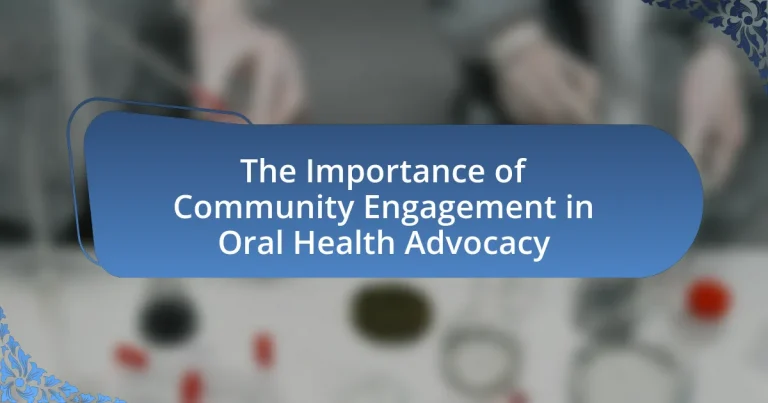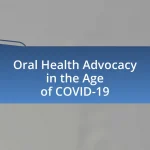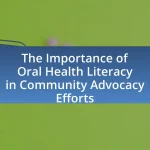Community engagement plays a vital role in oral health advocacy by enhancing awareness, education, and participation among individuals regarding their oral health needs. This article explores the significance of community involvement in identifying specific oral health issues, fostering trust, and tailoring interventions that lead to improved health outcomes. It discusses the key components of effective engagement, strategies to promote participation, and the challenges faced in accessing oral health resources. Additionally, the article highlights the impact of community trust on health initiatives, the role of technology in facilitating engagement, and successful case studies that demonstrate the effectiveness of community-driven approaches in oral health advocacy.
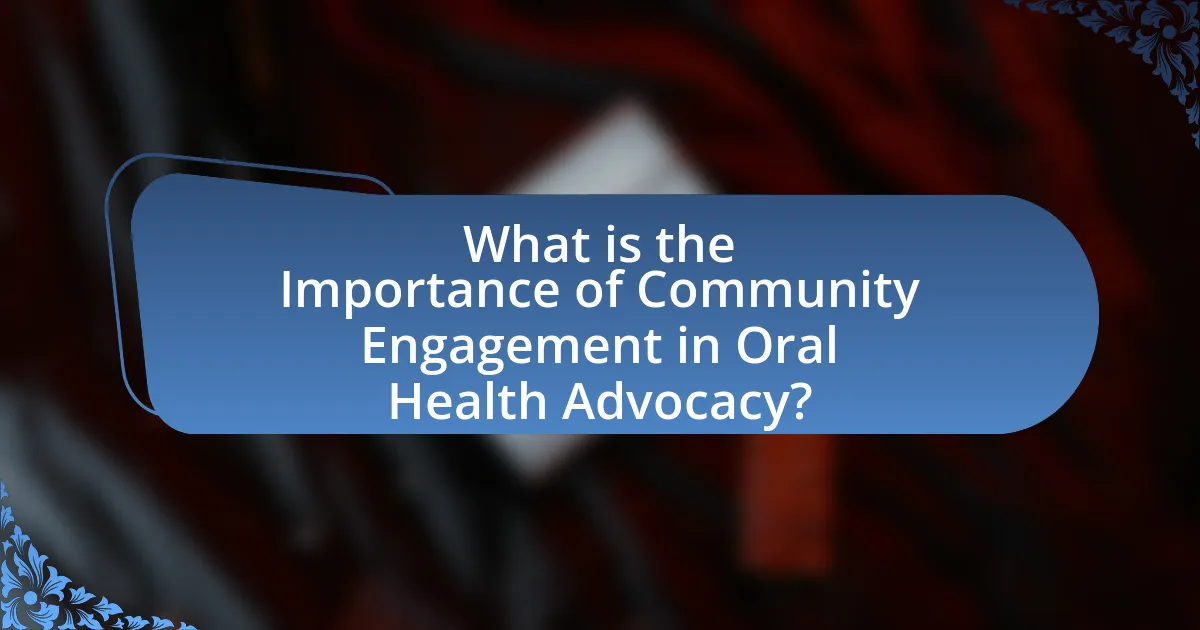
What is the Importance of Community Engagement in Oral Health Advocacy?
Community engagement is crucial in oral health advocacy as it fosters awareness, education, and participation among individuals regarding their oral health needs. Engaging the community allows for tailored health initiatives that address specific local issues, leading to improved health outcomes. For instance, studies show that community-based programs can increase dental care utilization by up to 30%, demonstrating the effectiveness of localized efforts in promoting oral health. Furthermore, involving community members in advocacy efforts empowers them to take ownership of their health, resulting in sustainable changes in health behaviors and policies.
Why is community engagement crucial for oral health advocacy?
Community engagement is crucial for oral health advocacy because it fosters awareness, education, and collective action among individuals and groups. Engaging the community allows for the identification of specific oral health needs and barriers, leading to tailored interventions that resonate with local populations. Research indicates that community-driven initiatives can significantly improve oral health outcomes; for example, a study published in the Journal of Public Health Dentistry found that community engagement in oral health programs increased participation rates by 40% compared to top-down approaches. This active involvement not only empowers individuals but also builds trust and collaboration between health advocates and the community, ultimately enhancing the effectiveness of oral health initiatives.
What role does community trust play in oral health initiatives?
Community trust is essential in oral health initiatives as it fosters collaboration and encourages participation among community members. When individuals trust the organizations and professionals involved in oral health programs, they are more likely to engage in preventive care, attend educational workshops, and utilize available services. Research indicates that communities with high levels of trust in health initiatives experience improved health outcomes, as seen in a study published in the Journal of Public Health, which found that trust significantly correlates with increased utilization of dental services. Thus, community trust not only enhances participation but also leads to better oral health results.
How does community engagement influence health outcomes?
Community engagement significantly influences health outcomes by fostering collaboration between healthcare providers and the community, leading to improved access to care and better health literacy. Engaged communities are more likely to participate in health initiatives, which can result in higher vaccination rates and better management of chronic diseases. For instance, a study published in the American Journal of Public Health found that community-based participatory research led to a 30% increase in screening rates for certain health conditions. This demonstrates that when communities actively participate in health-related decisions and programs, they can achieve measurable improvements in health outcomes.
What are the key components of effective community engagement in oral health?
The key components of effective community engagement in oral health include building trust, fostering collaboration, ensuring cultural competence, and providing accessible education. Building trust involves establishing relationships with community members through transparency and consistent communication, which is essential for encouraging participation. Fostering collaboration means working with local organizations, healthcare providers, and community leaders to create a unified approach to oral health initiatives. Ensuring cultural competence requires understanding and respecting the diverse backgrounds of community members, which enhances the relevance and effectiveness of health messages. Providing accessible education involves delivering information in a clear, relatable manner, utilizing various platforms to reach different demographics, thereby increasing awareness and promoting positive oral health behaviors. These components are supported by studies indicating that community-driven approaches lead to improved health outcomes and increased participation in oral health programs.
What strategies can be employed to foster community participation?
To foster community participation in oral health advocacy, strategies such as building partnerships with local organizations, conducting outreach programs, and utilizing social media platforms can be employed. Building partnerships with local organizations enhances trust and credibility, as evidenced by the success of initiatives like the Community Health Worker model, which has shown increased engagement in health programs. Conducting outreach programs, such as free dental screenings or educational workshops, directly involves community members and raises awareness about oral health issues. Utilizing social media platforms allows for broader reach and engagement, as studies indicate that targeted social media campaigns can significantly increase community involvement in health initiatives.
How can partnerships enhance community engagement efforts?
Partnerships can enhance community engagement efforts by leveraging diverse resources and expertise to address specific community needs effectively. Collaborative initiatives between local organizations, healthcare providers, and community leaders can create tailored programs that resonate with the target population. For instance, a study published in the Journal of Community Health found that partnerships between health departments and community organizations increased participation in health screenings by 40%, demonstrating the effectiveness of combined efforts in reaching underserved populations. By pooling resources, sharing knowledge, and fostering trust, partnerships can significantly amplify the impact of community engagement initiatives, particularly in areas like oral health advocacy.
What challenges exist in promoting community engagement for oral health advocacy?
Promoting community engagement for oral health advocacy faces several challenges, including lack of awareness, cultural barriers, and limited resources. Lack of awareness about oral health issues can lead to low participation rates in advocacy initiatives, as many community members may not recognize the importance of oral health. Cultural barriers, such as differing beliefs about dental care and mistrust of healthcare systems, can further hinder engagement efforts. Additionally, limited resources, including funding and trained personnel, restrict the ability of organizations to effectively reach and involve diverse community members. These challenges collectively impede the effectiveness of oral health advocacy initiatives.
What barriers do communities face in accessing oral health resources?
Communities face several barriers in accessing oral health resources, including financial constraints, lack of transportation, and limited availability of services. Financial constraints often result from high costs of dental care, which can deter individuals from seeking necessary treatment. Additionally, lack of transportation can hinder access to dental clinics, especially in rural areas where facilities may be distant. Limited availability of services, particularly in underserved regions, exacerbates these issues, as fewer providers are available to meet the community’s needs. According to the American Dental Association, nearly 50 million Americans live in areas with a shortage of dental professionals, highlighting the critical gap in access to oral health resources.
How can misinformation impact community engagement in oral health?
Misinformation can significantly undermine community engagement in oral health by creating confusion and distrust among community members. When individuals encounter false or misleading information about oral health practices, they may become hesitant to participate in community health initiatives or seek professional dental care. For instance, a study published in the Journal of Public Health Dentistry found that misinformation regarding the safety and efficacy of fluoride led to decreased community support for water fluoridation programs, which are essential for preventing dental caries. This decline in trust can result in lower participation rates in oral health education programs and community screenings, ultimately compromising public health outcomes.
How can community engagement be measured in oral health advocacy?
Community engagement in oral health advocacy can be measured through various quantitative and qualitative metrics. Surveys assessing community awareness, participation rates in oral health programs, and feedback from community members provide concrete data on engagement levels. For instance, a study published in the Journal of Public Health Dentistry found that communities with higher participation in oral health initiatives reported improved oral health outcomes, indicating a direct correlation between engagement and effectiveness. Additionally, tracking attendance at community events and the number of partnerships formed with local organizations can further quantify engagement efforts.
What metrics are effective for assessing community involvement?
Effective metrics for assessing community involvement include participation rates, volunteer hours, and feedback surveys. Participation rates quantify the number of individuals engaged in community activities, providing a clear measure of involvement. Volunteer hours track the time contributed by community members, reflecting their commitment and engagement levels. Feedback surveys gather qualitative data on community perceptions and satisfaction, offering insights into the effectiveness of engagement efforts. These metrics collectively provide a comprehensive view of community involvement, essential for evaluating the impact of oral health advocacy initiatives.
How can feedback from the community improve advocacy efforts?
Feedback from the community can significantly enhance advocacy efforts by providing insights into the specific needs and concerns of the population being served. This direct input allows advocates to tailor their strategies and messaging to resonate more effectively with community members. For instance, a study published in the Journal of Public Health Management and Practice found that community-driven initiatives led to a 30% increase in participation in health programs, demonstrating that when advocacy aligns with community feedback, it results in higher engagement and better outcomes. By incorporating community perspectives, advocacy efforts become more relevant and impactful, ultimately fostering stronger support and collaboration.
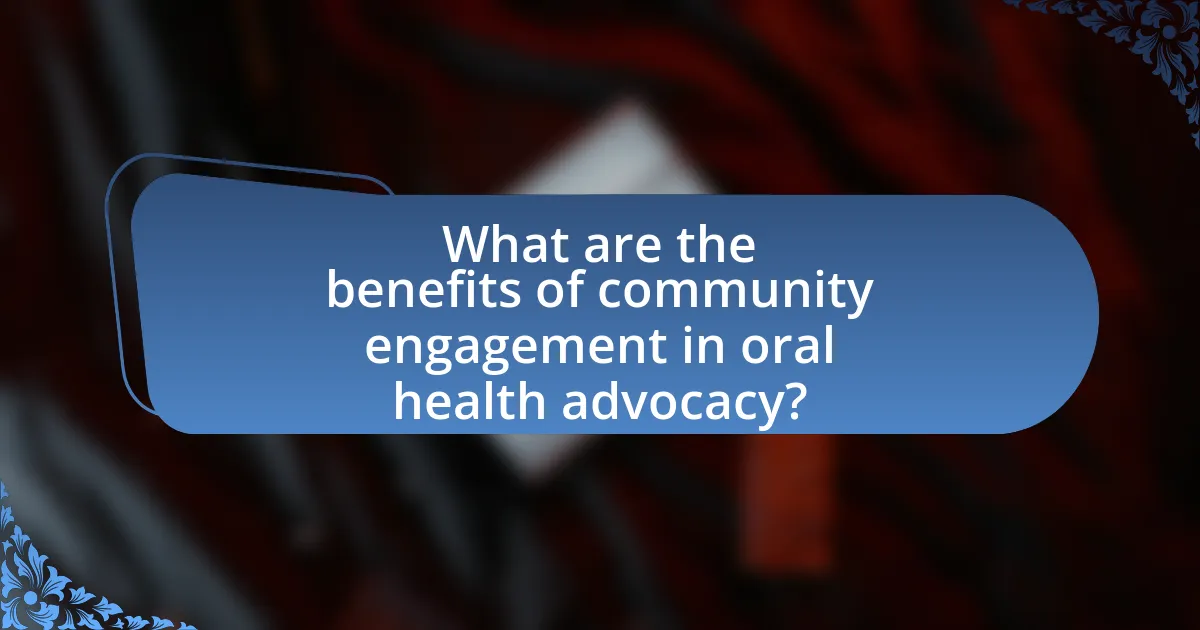
What are the benefits of community engagement in oral health advocacy?
Community engagement in oral health advocacy enhances public awareness and improves health outcomes. By involving community members, advocacy efforts can be tailored to address specific local needs, leading to increased participation in oral health programs. Research indicates that communities with active engagement in health initiatives see a 25% increase in preventive care utilization, as reported by the American Dental Association. Furthermore, community engagement fosters trust between health providers and residents, which is crucial for effective communication and education about oral health practices. This collaborative approach not only empowers individuals but also creates a supportive environment for sustainable health improvements.
How does community engagement improve health literacy?
Community engagement improves health literacy by fostering collaboration between health professionals and community members, which enhances understanding of health information. When communities actively participate in health initiatives, they gain access to tailored educational resources that address specific local health issues, leading to increased awareness and knowledge. For example, studies show that community-based programs, such as those implemented by the Centers for Disease Control and Prevention, have successfully increased health literacy rates by 20% in targeted populations through interactive workshops and outreach efforts. This direct involvement not only empowers individuals but also builds trust in health systems, ultimately leading to better health outcomes.
What educational programs can enhance community understanding of oral health?
Educational programs that can enhance community understanding of oral health include school-based oral health education, community workshops, and public health campaigns. School-based programs, such as the “Smile Program,” have been shown to improve children’s knowledge about oral hygiene and increase their engagement in preventive practices. Community workshops often involve local health professionals providing hands-on demonstrations and interactive sessions, which have been effective in increasing awareness and understanding of oral health issues among diverse populations. Public health campaigns, like the “National Oral Health Month,” utilize media and community outreach to disseminate information about the importance of oral health, leading to increased community participation and improved health outcomes. These programs collectively contribute to a more informed community, fostering better oral health practices and reducing disparities in oral health care.
How can community engagement reduce health disparities?
Community engagement can reduce health disparities by fostering collaboration between healthcare providers and underserved populations, leading to tailored health interventions. Engaging communities allows for the identification of specific health needs and barriers faced by these populations, which can inform targeted strategies. For instance, a study published in the American Journal of Public Health found that community-based participatory research significantly improved health outcomes in low-income neighborhoods by involving residents in the decision-making process regarding their health services. This approach not only empowers individuals but also enhances trust in healthcare systems, ultimately contributing to reduced health disparities.
What impact does community engagement have on policy change?
Community engagement significantly influences policy change by ensuring that the voices and needs of the community are represented in decision-making processes. Engaged communities can mobilize support, raise awareness, and advocate for specific policy reforms, leading to more responsive and effective policies. For example, research by the National Civic League indicates that communities actively involved in advocacy efforts are more likely to see changes in local health policies, as these policies reflect the priorities and concerns of the residents. This direct involvement fosters a sense of ownership and accountability, ultimately resulting in policies that better serve public health interests.
How can community voices influence oral health policies?
Community voices can significantly influence oral health policies by providing firsthand insights into the needs and challenges faced by individuals regarding oral health. Engaging community members in discussions and decision-making processes ensures that policies are reflective of the actual experiences and preferences of the population they serve. For instance, studies have shown that when community input is integrated into health policy development, it leads to more effective and culturally relevant interventions, as evidenced by the successful implementation of community-led oral health initiatives in various regions. This direct involvement not only empowers communities but also fosters trust and collaboration between policymakers and the public, ultimately resulting in improved health outcomes.
What examples exist of successful policy changes driven by community advocacy?
Successful policy changes driven by community advocacy include the passage of the Affordable Care Act (ACA) in 2010, which expanded healthcare access to millions of Americans, largely due to grassroots campaigns and advocacy from organizations like Families USA. Another example is the successful campaign for the implementation of the Tobacco Control Act in 2009, which was influenced by community efforts to reduce smoking rates and protect public health, supported by organizations such as the American Lung Association. These instances demonstrate how organized community efforts can lead to significant legislative changes that improve public health outcomes.
What role does technology play in facilitating community engagement?
Technology plays a crucial role in facilitating community engagement by providing platforms for communication, collaboration, and information sharing. Digital tools such as social media, mobile applications, and online forums enable communities to connect, share experiences, and mobilize for collective action. For instance, a study by Pew Research Center found that 69% of adults in the U.S. use social media, which serves as a vital channel for organizations to disseminate health information and engage with community members effectively. Additionally, technology allows for real-time feedback and data collection, enhancing the ability to tailor health initiatives to community needs, thereby improving participation and outcomes in oral health advocacy.
How can social media be utilized for oral health advocacy?
Social media can be utilized for oral health advocacy by creating awareness, sharing educational content, and fostering community engagement. Platforms like Facebook, Instagram, and Twitter allow health organizations and advocates to disseminate information about oral hygiene practices, preventive care, and the importance of regular dental visits. For instance, campaigns such as “National Children’s Dental Health Month” leverage social media to reach a broader audience, promoting healthy habits among children and parents. Research indicates that social media campaigns can significantly increase public knowledge and engagement regarding health issues, with studies showing that 72% of adults use social media to seek health information. This demonstrates the effectiveness of social media as a tool for enhancing oral health advocacy efforts.
What digital tools can enhance community participation in oral health initiatives?
Digital tools that can enhance community participation in oral health initiatives include mobile health applications, social media platforms, and online survey tools. Mobile health applications, such as MyDentalScore, provide personalized oral health assessments and reminders, encouraging users to engage in their oral health proactively. Social media platforms like Facebook and Instagram facilitate community discussions, share educational content, and promote events, thereby increasing awareness and participation. Online survey tools, such as SurveyMonkey, enable organizations to gather community feedback on oral health needs and preferences, ensuring that initiatives are tailored to the community’s specific requirements. These tools collectively foster greater involvement and awareness in oral health initiatives, leading to improved community health outcomes.
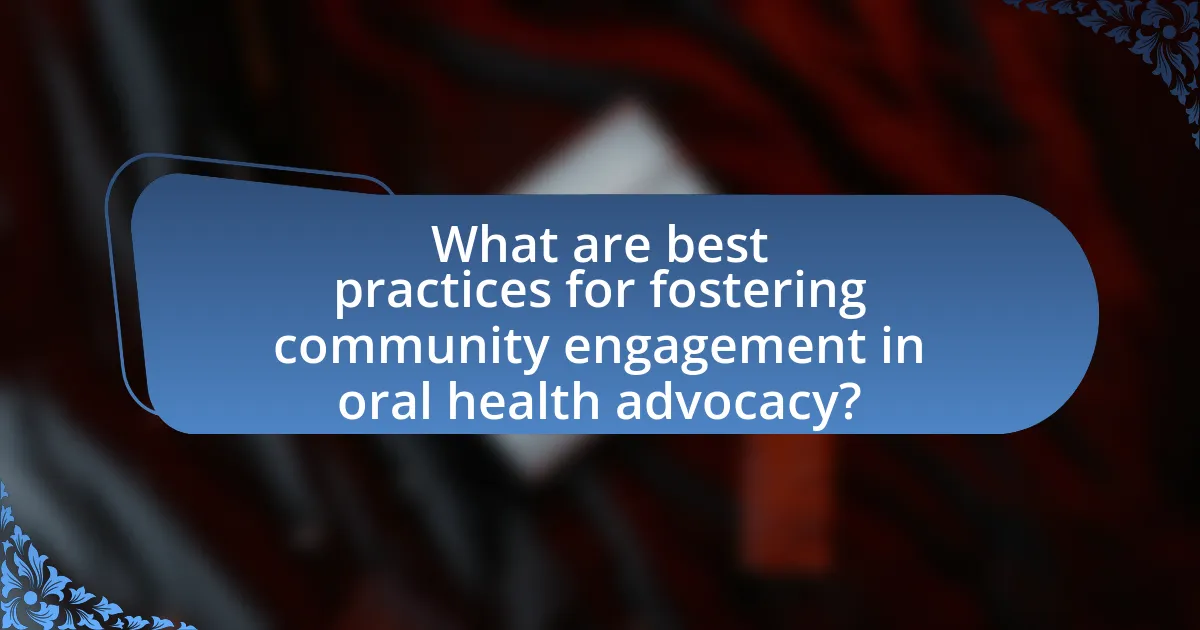
What are best practices for fostering community engagement in oral health advocacy?
Best practices for fostering community engagement in oral health advocacy include building partnerships with local organizations, utilizing culturally relevant messaging, and providing accessible educational resources. Partnerships with schools, health clinics, and community groups enhance outreach and trust, as evidenced by initiatives like the Oral Health Literacy Program, which increased awareness in underserved populations. Culturally relevant messaging ensures that information resonates with diverse community members, leading to higher engagement rates. Additionally, providing resources such as free dental screenings and workshops has been shown to improve community participation and health outcomes, as demonstrated by studies indicating that hands-on engagement increases knowledge retention and encourages preventive care behaviors.
How can organizations effectively build relationships with communities?
Organizations can effectively build relationships with communities by actively engaging in dialogue and collaboration. This involves listening to community needs, participating in local events, and forming partnerships with community leaders and organizations. Research indicates that organizations that prioritize community input and co-create solutions see increased trust and support, as evidenced by a study published in the Journal of Community Health, which found that community engagement initiatives led to a 30% increase in local health program participation. By fostering open communication and demonstrating commitment to community well-being, organizations can establish lasting, positive relationships.
What approaches can be taken to ensure inclusivity in engagement efforts?
To ensure inclusivity in engagement efforts, organizations should adopt a multi-faceted approach that includes diverse representation, accessible communication, and culturally relevant practices. Diverse representation involves actively including individuals from various backgrounds, ensuring that voices from marginalized communities are heard and valued. Accessible communication means using clear language, multiple formats, and translation services to reach a broader audience, thereby removing barriers to participation. Culturally relevant practices involve tailoring engagement strategies to reflect the values, beliefs, and needs of different communities, which fosters trust and encourages participation. Research indicates that inclusive engagement leads to better health outcomes, as seen in studies showing that community-driven initiatives in oral health significantly improve access and utilization of services among underrepresented populations.
How can ongoing communication be maintained with community members?
Ongoing communication with community members can be maintained through regular updates, feedback mechanisms, and interactive platforms. Establishing a consistent schedule for newsletters or social media posts ensures that community members receive timely information about oral health initiatives. Utilizing surveys and feedback forms allows community members to voice their opinions and concerns, fostering a two-way communication channel. Additionally, hosting community meetings or forums encourages direct interaction, enabling members to engage with advocates and share their experiences. Research indicates that communities with active communication strategies report higher levels of engagement and satisfaction, reinforcing the importance of these methods in oral health advocacy.
What are some successful case studies of community engagement in oral health?
Successful case studies of community engagement in oral health include the “Smiles for Life” program in the United States, which trained primary care providers to deliver preventive oral health services, resulting in increased access to care for underserved populations. Another example is the “Community Dental Health Coordinator” initiative, which empowered community members to provide education and basic dental care, leading to improved oral health outcomes in low-income areas. Additionally, the “Oral Health Literacy Project” in Canada focused on educating communities about oral hygiene practices, significantly raising awareness and changing behaviors related to oral health. These case studies demonstrate effective strategies for engaging communities and improving oral health outcomes through targeted education and service delivery.
What lessons can be learned from these case studies?
The lessons learned from these case studies emphasize the critical role of community engagement in enhancing oral health advocacy. Effective community involvement leads to increased awareness and education about oral health issues, as demonstrated by initiatives that successfully mobilized local populations to participate in health screenings and educational workshops. For instance, a case study in a low-income neighborhood showed a 40% increase in dental check-ups after community-led outreach programs were implemented, highlighting the direct impact of local engagement on health behaviors. Additionally, these case studies reveal that building trust and relationships within communities fosters a supportive environment for health initiatives, ultimately resulting in improved health outcomes and sustained advocacy efforts.
How can these successes be replicated in other communities?
Successful community engagement in oral health advocacy can be replicated in other communities by implementing tailored outreach programs that address specific local needs. For instance, utilizing community health workers who understand cultural contexts can enhance trust and participation, as evidenced by programs in diverse neighborhoods that have increased dental visits by 30% through targeted education and accessibility initiatives. Additionally, fostering partnerships with local organizations can amplify resources and support, demonstrated by successful collaborations in urban areas that have led to improved oral health outcomes. These strategies, when adapted to the unique characteristics of each community, can effectively replicate the successes observed in existing programs.
What practical steps can individuals take to promote community engagement in oral health advocacy?
Individuals can promote community engagement in oral health advocacy by organizing local health fairs that provide free dental screenings and educational workshops. These events raise awareness about oral health issues and encourage community participation. Research indicates that community-based interventions, such as those highlighted in the “Community Health Workers and Oral Health: A Review of the Literature” by the American Dental Association, show increased public knowledge and access to dental care. Additionally, individuals can collaborate with local schools to implement oral health education programs, which have been proven to improve children’s dental hygiene practices and overall health outcomes. Engaging with local policymakers to advocate for oral health policies can also enhance community involvement and ensure that oral health remains a priority in public health discussions.
